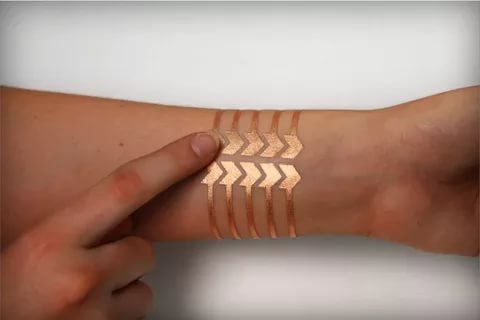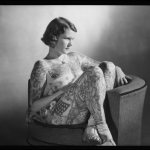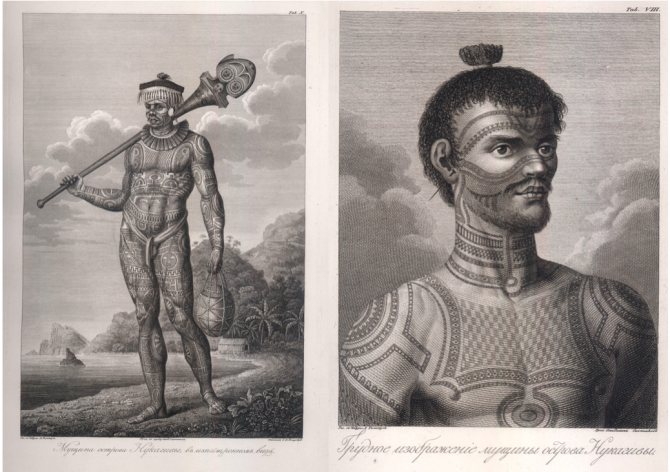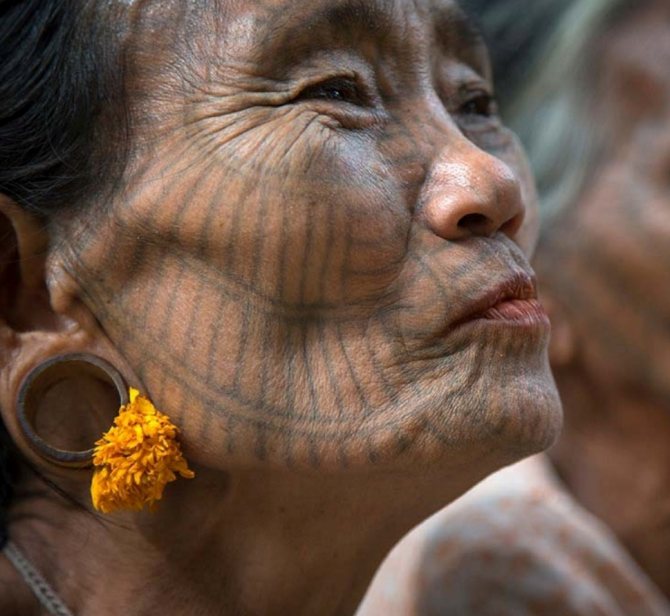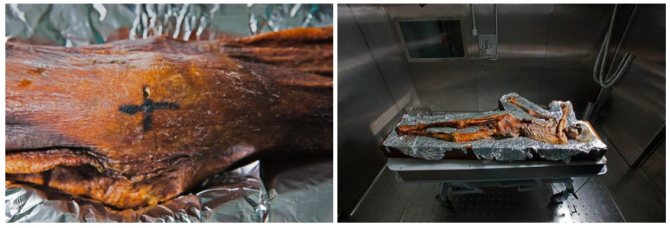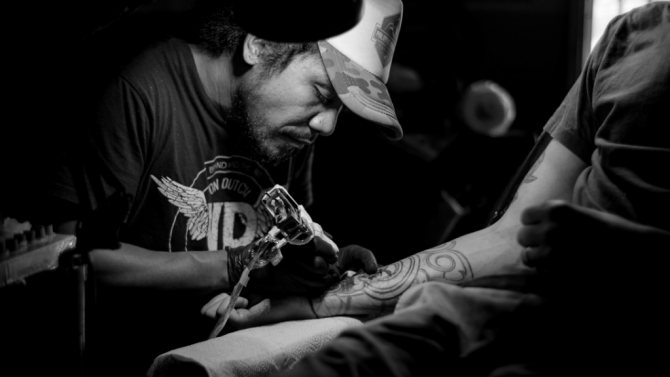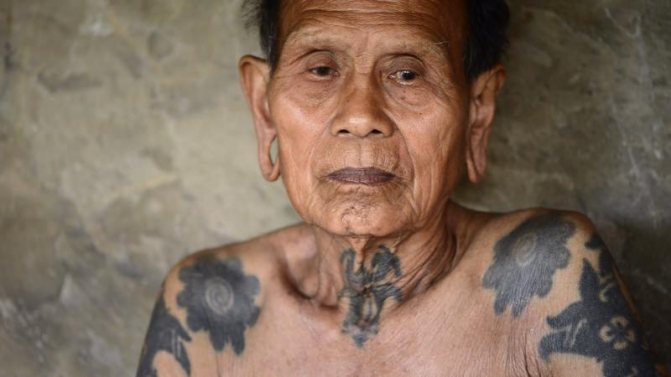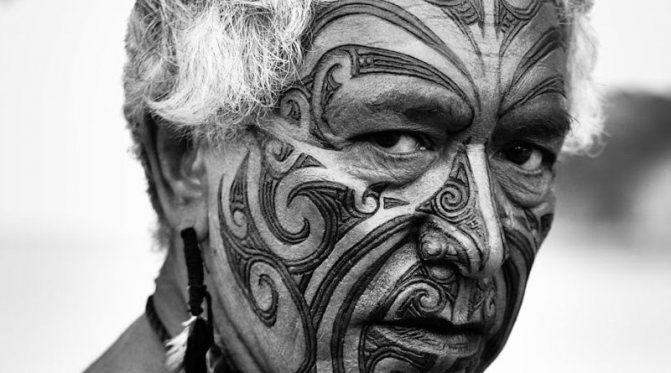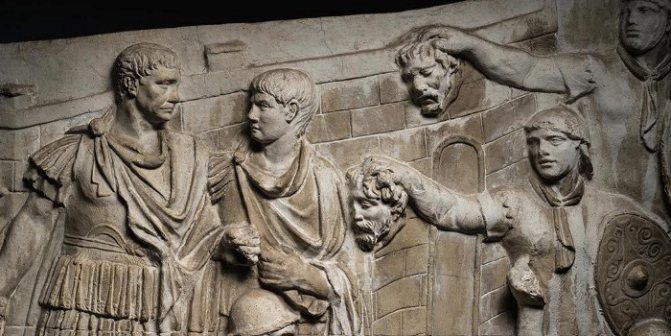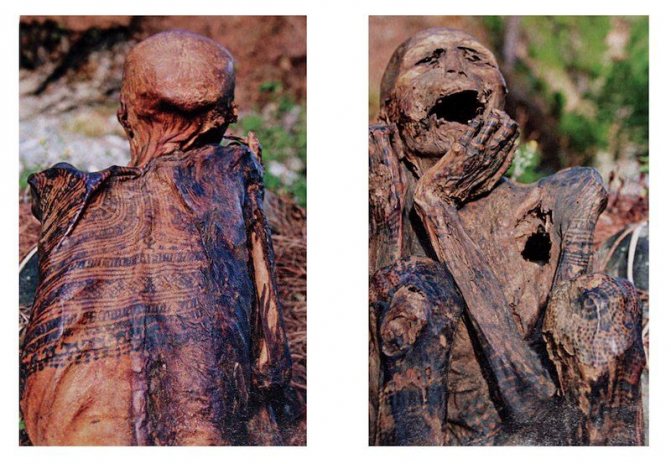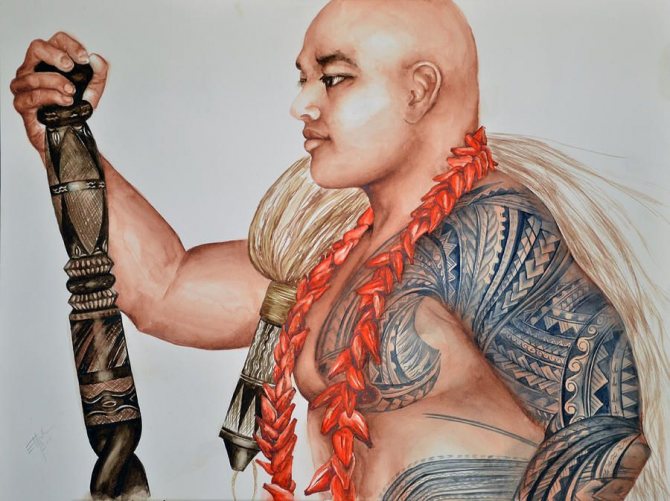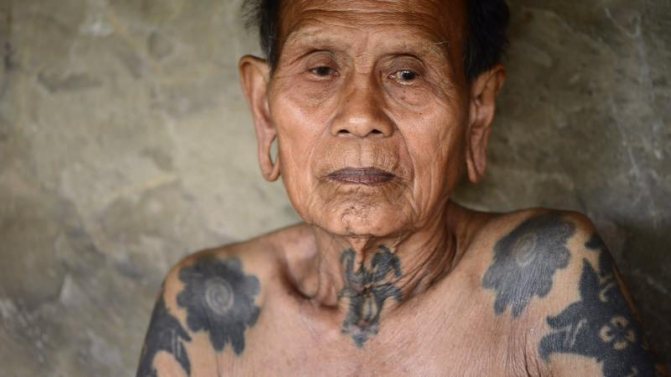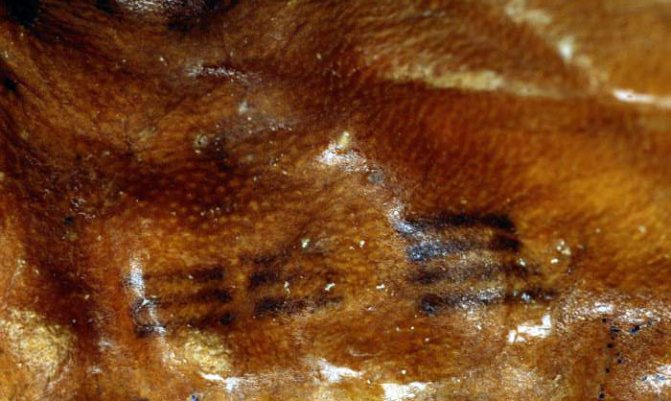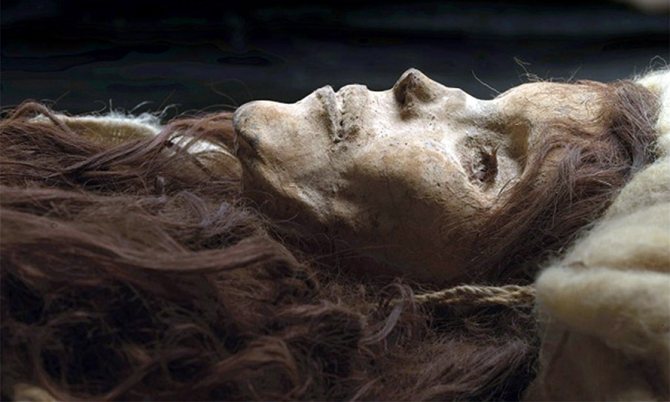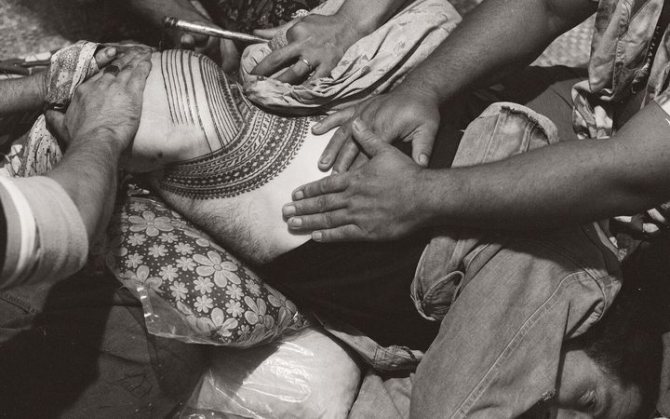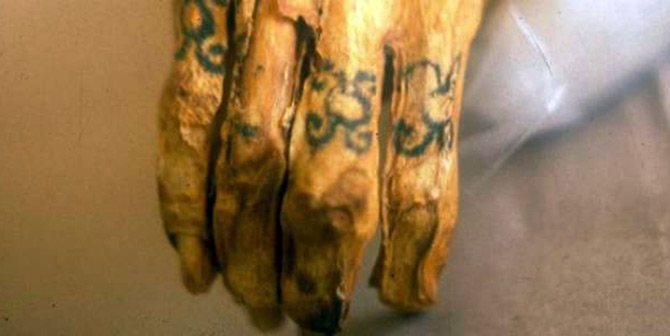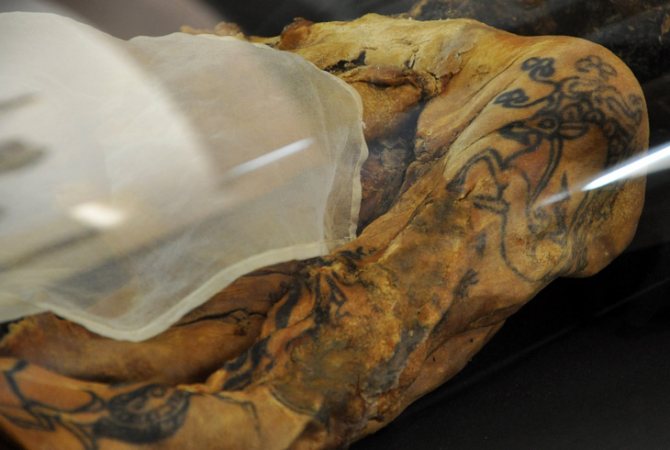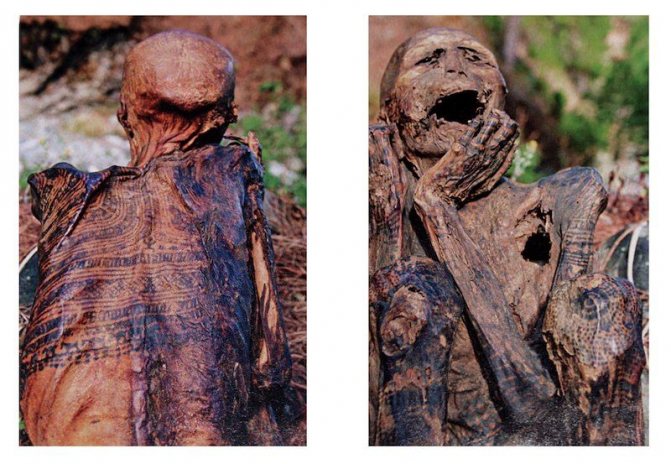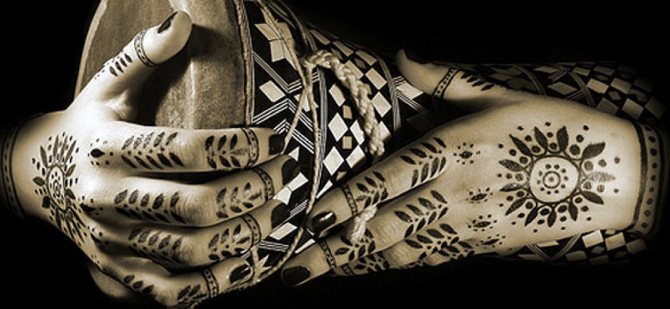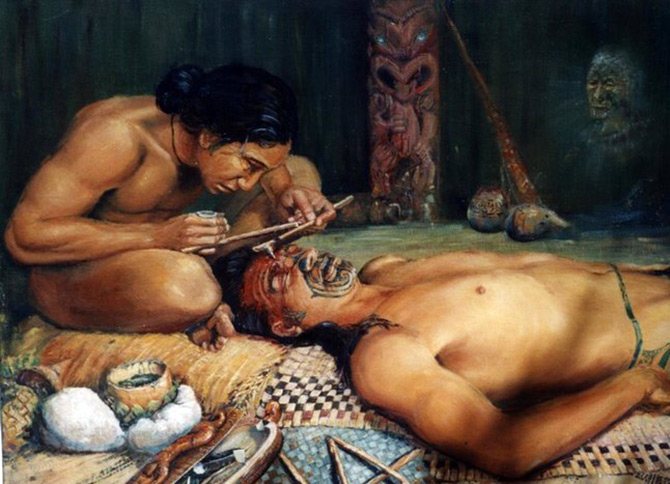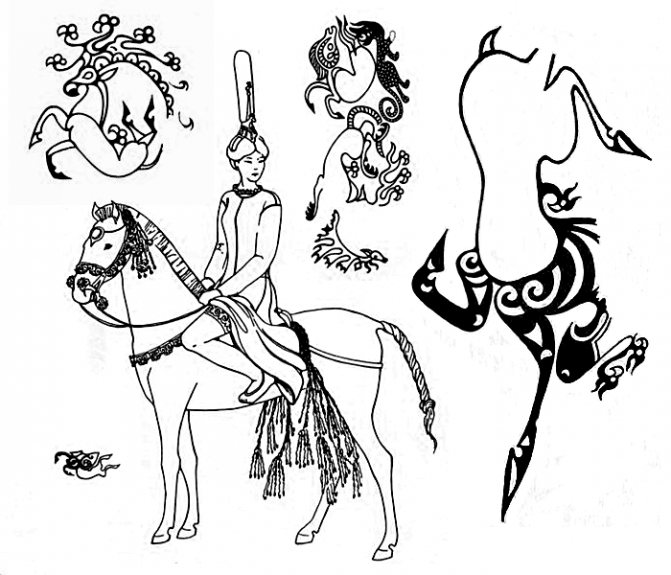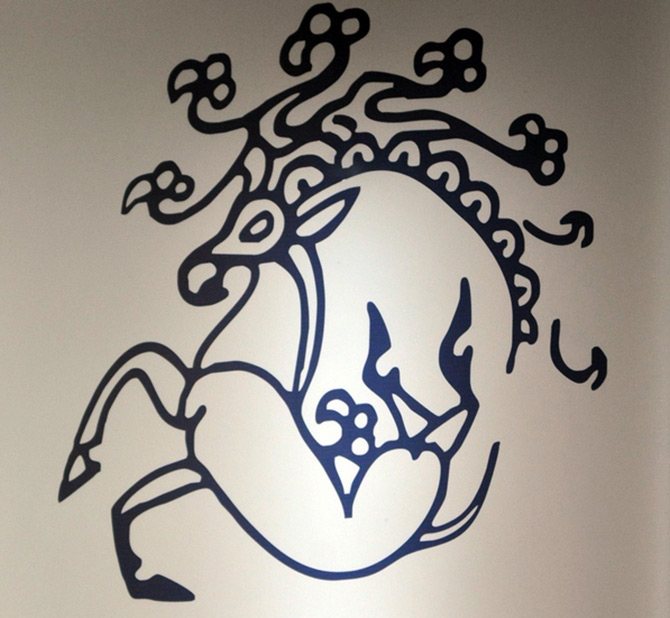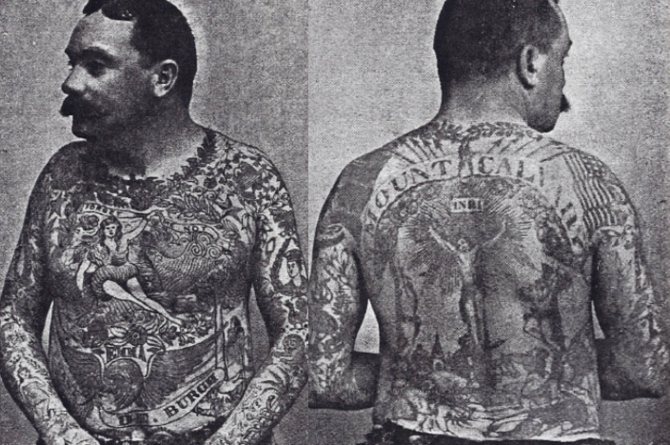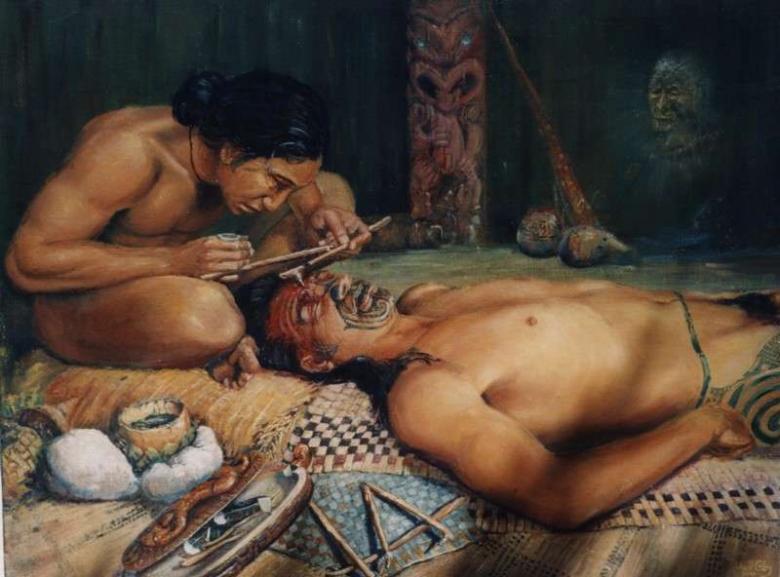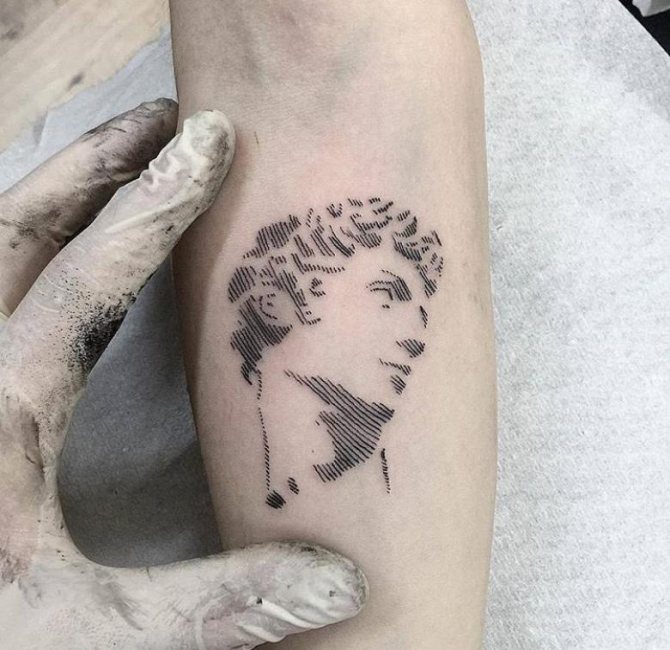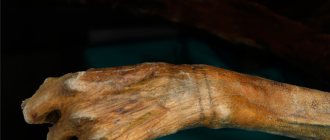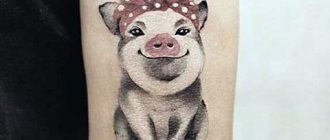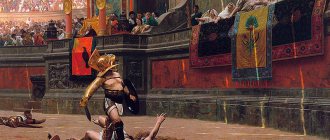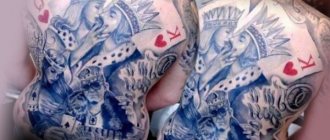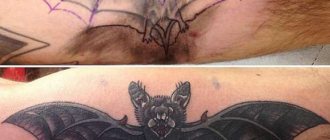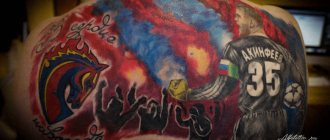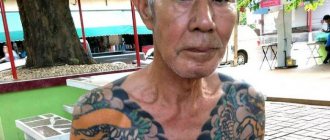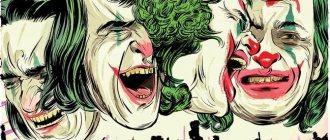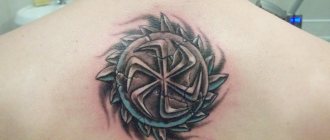History of tattooing
The history of tattooing goes back at least 6,000 years.
The oldest tattoos were found at the excavations of the Egyptian pyramids. Mummies are about four thousand years old, but the drawings on the dried skin are clearly distinguishable. However, the tattoo appeared much earlier - during the primitive communal system. It served not only as an ornament, but also as a sign of the tribe, clan, totem, indicated the social belonging of its owner and, moreover, was endowed with a certain magical power.
The deep historical roots of tattooing are no less impressive. Various types of tattoos were practiced among light-skinned peoples all over the world, and were replaced by scarring among dark-skinned people. The tattoos were used by all - different tribes of Europe and Asia, Indians of North and South America and, of course, inhabitants of Oceania.
The tattoos of different peoples were endowed with the most diverse magical properties: children were protected from parental anger, adults were protected in battle and hunting, elders were protected from illnesses. But the magic of tattoos was used not only by "savages".
What is a tattoo
At all times man, unlike other living beings inhabiting the Earth, tried to change his appearance and make his appearance different from what he was given by nature. The human body in its absolutely natural form is difficult to find, even in the most remote corners of the globe. Tattoo - one of the oldest ways to decorate and modify the body, but it is the tattoo most often causes a violent reaction of others, while other everyday modifications and reflection of his image, such as hair, manicure and even more so, clothes are considered perfectly ordinary and even obligatory.
There are many ways to change your appearance directly on the body. This and piercing, and temporary henna painting and scarring. It is generally accepted that a tattoo is an indelible mark that is applied with a dye pigment injected under the skin. In Africa it is scarring that is most widespread, most likely because the dark skin practically does not show the dye, which was most often used as soot from the hearth. On the black continent they took a different path and began to apply three-dimensional images by scarification and even by implanting objects under the skin. Something similar can be observed in other regions of the earth where the population has a darker shade of skin. For example, Australian aborigines and Papua New Guinea islanders in Oceania also used scarring. In fact, it is a common phenomenon with tattooing, that is, it is a sign that you cannot remove or remove if you wish, but it is a different way.
It happens that several techniques are combined, along with scarring, pigment is rubbed into the skin to enhance the effect. This, for example, is done by the Maori, who inhabit the southern part of Oceania - New Zealand (the exhibition will feature casts of Maori heads from the Kunstkamera, a plaster cast of a dried head and other exhibits from the collection of the Quai Branly Museum, archival photographs, and an engraving from the collection of the Pushkin Museum of Fine Arts).
Charles Darwin believed that tattooing could be attributed to one of the mechanisms of sexual selection, as a way in which a person adorns himself and makes himself more attractive to a potential partner. Indeed, many peoples apply tattoos as a sign of beauty, but this is a very narrow interpretation. Tattooing has had many functions and purposes. It is a phenomenon with broad both geographical and semantic boundaries.
Modern tattoo culture: a man with a work of art on his back
The tattoo has long ceased to be an element of amusement spectacles. Now the picture on the human body is a part of modern visual culture, a way of communication, and for some it is a symbol of a transitional moment in life.
Such a moment was the tattoo for Tim Steiner, the former manager of a tattoo parlor from Zurich.
In 2006, the artist Wim Delvoie, famous for his provocative works, was looking for someone who wanted to become a living canvas. Tim was invited to participate in the project, and he didn't hesitate to accept.
Two years later, a tattoo appeared on his back: a praying Virgin Mary with a rosary in her hands, topped with a Mexican-style skull. Delvoie spent 40 hours on the job.
Steiner later signed a contract with a German gallerist under the terms of which, after Tim's death, a fragment of his tattooed skin would be sold to anyone interested.
Today it is a living exhibit: at least three times Tim is obligated to exhibit his back in museums. Steiner himself says his skin is a work of art, and he's just a guy who wears it temporarily.
The oldest tattoos
Tattooing as a phenomenon has very ancient roots. The oldest date back to the Eneolithic period, a transitional period from the Stone Age to the Bronze Age. Etzi, the mummy found in the ice of South Tyrol is covered with numerous but very simple tattoos in the form of geometric lines and dots, there are no complex patterns on it, much less paintings. Scientists tried to analyze their meaning, however it is very difficult to make any interpretations related to Prehistoric period because there are very few monuments (household items, fine art) with which these tattoos could be compared. The most working theory is that the tattoos on the body of the mummy Etzi had a therapeutic nature (something akin to acupuncture). Perhaps it worked like acupuncture, since these rudimentary tattoos were located at certain points on his body (joints, spine, etc.).
Recent discoveries have shown that tattoos were also made in Ancient Egypt from as far back as the Pre-Dynastic period: in 2021. Using infrared light photography of mummies from Gebelein, stored in the British Museum, researchers were able to identify tattoos on mummies that were made more than 5,000 years ago. And the tattoos were found on both male and female mummies, although previously it was believed that in ancient Egypt only women decorated their bodies with tattoos. And it was not only the simplest drawings, but more complex figurative images. For example, on the arm of a mummy of a young man was found the image of a grizzly ram and a wild bull. More recent tattoos from the New Kingdom era (13th-11th century B.C.) were found by French researchers more recently, in 2021 and 2018.
One of their finds is a female mummy of a priestess from Deir el-Medina, whose tattoos are very similar to the ornaments seen on the famous exhibit in the Ancient Egyptian collection of the A.S. State Museum of Fine Arts. Pushkin - on a spoon with a lotus flower with a handle in the form of a floating girl. It is possible to discern ornamental patterns on it: a necklace on the neck, a pattern on the waist and on the outside of the thighs. Finds of tattooed mummies suggest that there are tattoos on the spoon as well: the ornament on the girl's waist is very similar to the one on the mummy from Deir el-Medina both in its location, shape and lines. A tattoo in the form of two lotus flowers connected by a dotted line similar to the "belt" on a Moscow spoon was found on a female mummy from Deir el-Medina in the lower back.
Another page of the most ancient history of tattooing are the mummies found in the Altai Mountains and Khakassia. These are the Pazyryk (6th - 3rd centuries BC) and Tashtyk (2nd - 5th centuries AD) cultures. The mummies themselves will not be represented at the exhibition, they are the rarest finds and most of them are in the Hermitage, and the famous princess from the Ukok remains in Altai. These finds require special treatment and rarely travel. This oldest page of tattoo history is associated with the Russian region.
Tattooed Venus
However, not all circus performers invented stage legends for themselves, and some were even adamantly opposed.
Betty Broadbent fell in love with the art of tattooing at age 14 after seeing a man showing his images to street gawkers. By the age of 18 years on her body could be counted more than 350 (and later 565) drawings of different subjects, from images of historical figures to drawings based on biblical subjects.
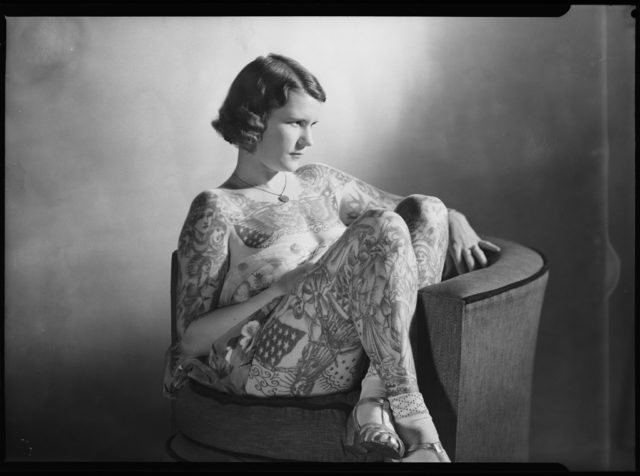
Betty has spent most of her life touring circus sideshows, performing under the effective pseudonym of the tattooed Venus. She refused to make up her own legend and insisted that body-paintings without any stories drew attention to herself - as the saying goes, "first of all, it's beautiful. Betty never stripped more than was acceptable at the time - her usual stage costume was a closed swimsuit - and she did not take part in vulgar shows.
Unwilling to arouse the public's interest with gossip and overly explicit performances, Betty looked for new ways to surprise audiences. So she became a member of the growing popularity of performances with horses and for a time worked as a rider in the show called "Wild West".
Ban on Tattoos
The Christian religion forbade tattooing. An explicit prohibition against marking one's body can be found in the Bible in the book of Leviticus: "For the sake of the dead, do not make cuts on your body and do not tattoo writing on yourself. I am the Lord" (Leviticus 19:28). But at the same time tattoos were popular among the Christian population of the Middle East. Copts and Syrian Christians visiting the Holy Land and feeling minority in their native land received this sign - a mark of their religious affiliation. In the XI century, during the first crusades, the Christian church even allowed tattoos for a time. To spare the crusaders fear of dying far from their homeland, the Church allowed the tattoo of a cross on the inside of the wrist, which in the event of death had the same effect as a burial according to Christian canons.
No prophet in his own country
When the Japanese borders opened to foreigners in 1854, American sailors were among the first of the outside world to see tattoos on Japanese bodies. Many members of the working professions, such as carpenters or peddlers, walked the streets with exposed body parts. These tattoos captured the imagination of Americans. At the same time, Japan banned tattoos on the skin of local residents because, according to the authorities of the time, tattooing was a barbaric practice. The ban was in effect from 1872 to 1948. In spite of this, Japanese tattooing made its way out of the country. In the postwar period in Japan, tattooing became an attribute of the Yakuza and became firmly associated with the mafia structures.
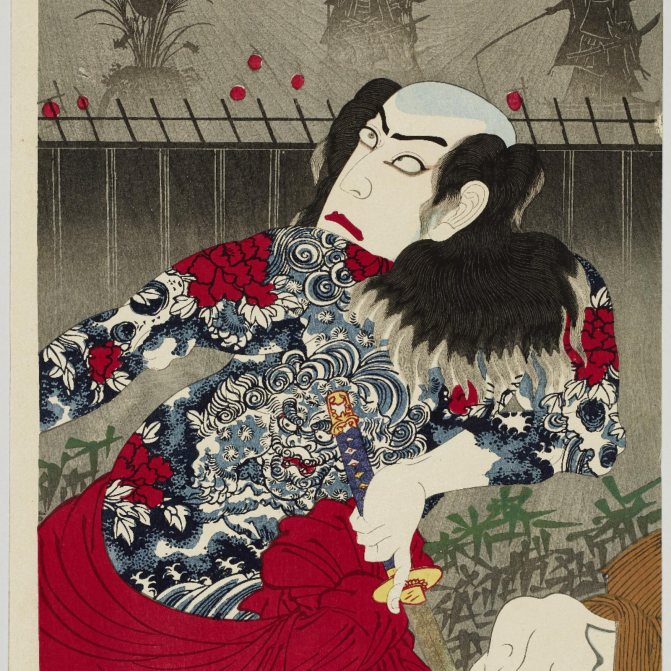

Toyohara Kunichika, Ichikawa Sadanji I as Issun Tokubei in the play Natsumatsuri. Source: Press Service of the Pushkin State Museum of Fine Arts
The early Japanese tattoo was closely connected with the Japanese engravings of the Edo period and its stylistic features, and it was these features that first impressed American sailors and later artists, and especially the fact that it was not a figurative tattoo, but a colored one covering large areas of the body - "suits". If the world, mainly where there was a tattoo tradition reigned unicolor ornamental tattoo, in Japan has formed a completely different kind of tattoo. Apart from the typical Japanese images - carp, chrysanthemums and sakura blossoms - the tattoo form itself was also very different from everything else that both Americans and Europeans could observe in traditional tribes and societies.
Americans, inspired by the colorful Japanese tattoo, began to develop its forms at home. American artisans entered into correspondence with Japanese artisans (Sailor Jerry), exchanging sketches, techniques. One of the first styles to form was what is now known as old school. These are tattoos with a bright, clear outline and colored filler. This is not comparable to what is traditional in Japan, but thanks to this influence color appeared in the world tattoo. First red, yellow, green and blue-green. During the twentieth century, the palette of artists expanded. For some colors, we even know the names of the artists who developed and introduced them. For example, purple was introduced by Don Ed Hardy, a student of Sailor Jerry, one of the most famous tattoo artists and founder of the old skool school. Today, tattoo artists are not limited in the means of expression, they have access to any colors and shades, but this way was launched by an acquaintance with the Japanese tradition.
Americans were inspired by Japanese tattooing, although the Native American population had its own very diverse tattoo tradition, which with the arrival of the colonists was closed within the borders of reservations. And in America there was such a strange situation that despite the fact that this tradition existed in the indigenous population, the relationship with them the colonists "did not work out", and later they were inspired by the overseas Japanese tradition.
Now Native Americans are undergoing a revival of their traditional tattoo. It's a difficult road, because in many ways it has been lost, as well as language and beliefs. Nevertheless, the revival process has begun, and many young Native Americans are working with anthropologists and historians to help revive Native traditions, including tattooing.
Modern Tattoo History
The beginning of modern tattoo fashion can be considered 1891, when American Samuel O'Reilly created the first tattoo machine. Then came the first professional tattoo artists and special salons.
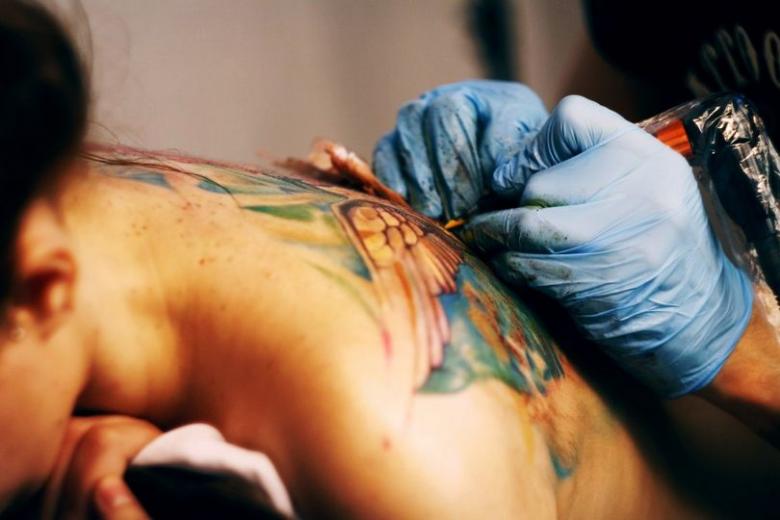

Initially, tattoos were thought to be inherent to the lower classes and outcasts. Nevertheless, in the 1800s and 1900s the grandchildren of Queen Victoria, Winston Churchill, his mother and President Franklin Roosevelt all had tattoos.
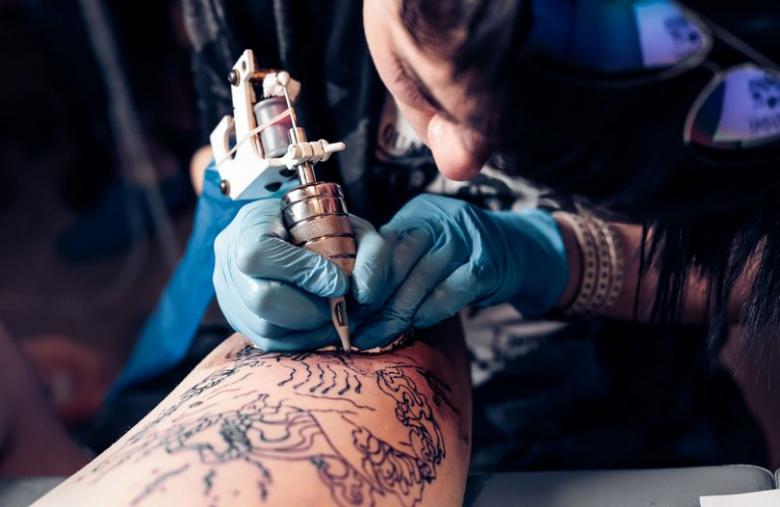

Slowly, but society began to take an interest in tattooing. Rock star Janis Joplin was the first to show that with a tattoo you could be both extraordinary and popular. Nowadays, tattoos are very common among rock stars and elites of different countries.
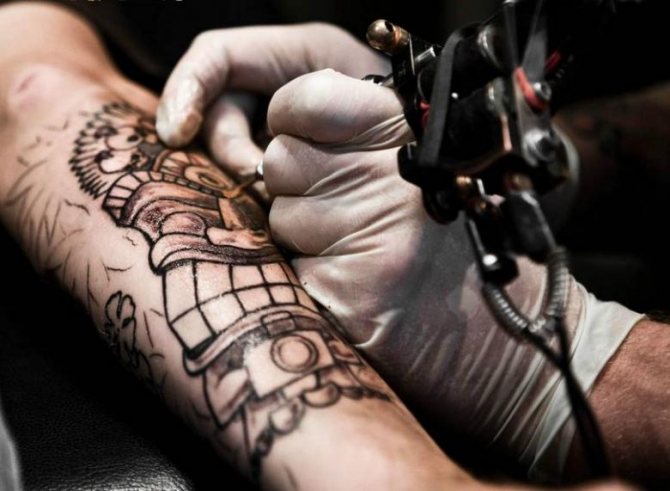

There are also tattoo museums. One of the first to open was a museum in San Francisco. The collection is dedicated to the art of tattooing and its history since 1898. Opened the museum Lyle Tuttle - tattooist many celebrities.
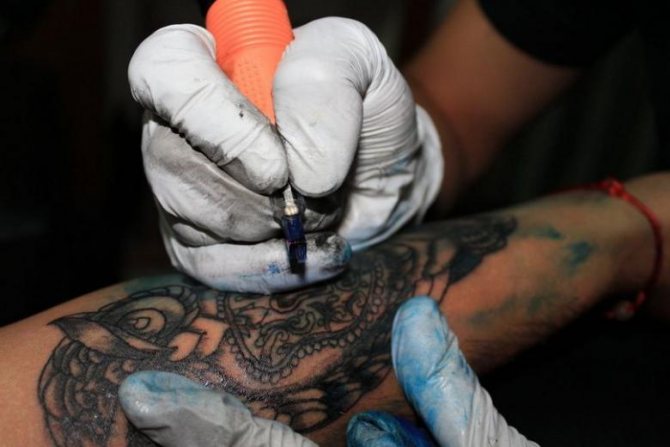

With the advent of the tattoo, which dates back some 6,000 years, people have added a number of functions to its meaning: protective, social, magical and decorative. In modern society, however, the tattoo is perceived as a way of self-expression.
The tattoo among the Nordic peoples
Unfortunately, the same cannot be said of the indigenous population of northern Russia. The Northeast of Russia and the Northwest of America was a single cultural field - Bering Sea - and there was a tattooing tradition also, and quite long ago. The finds of archaeologists connected with the Ancient Berengomor culture suggest that this culture is very ancient. Among them are small bone amulets depicting human faces with grooves on the chin. It is known from later sources that female tattooing among the peoples of the North had a simple geometric character on the face: either parallel strips on the chin or parallel strips from the nose to the forehead with some variations depending on the region. For example, in Chukotka they are two simple stripes from the nose, and on St. Lawrence Island the Eskimos have them also geometric, but they are more complex patterns on the face and hands, that is, on the places that can be seen.
On St. Lawrence Island the tattoo, traditional for these places, was recorded by our navigators of the northeastern expedition of Billings-Sarychev, who visited the island. In the atlas published by this expedition and presented at the exhibition in the Pushkin State Museum of Fine Arts, we find an image of a woman with such tattoos, but it is signed as "an inhabitant of the Chukchi land". At that time there was no clear definition made by anthropologists later. The same tattoo can be seen on an engraving from the late eighteenth century, and it continued to live until the end of the twentieth century.
American anthropologist Lars Krutak visited St. Lawrence Island in the late 1990s. He photographed the last bearers of this traditional facial tattoo. There was a danger that this tradition, along with these residents will be lost and gone, but it did not happen, because the younger population picked up the tradition and now there are master tattooists who have mastered this knowledge and continue to apply the tattoo and wear it themselves.
At the same time, in our Chukotka women's facial tattoos can leave us, if not today, then tomorrow. The bearers of this tattoo are still alive, but they can be counted on the fingers of one hand. There are only four women left. We do not yet have a wave of revival of our traditional culture. On the contrary, the population of Chukotka tends to go somewhere else and start leading a different way of life. It is possible that in our country this tradition will be broken, but it was captured by the St. Petersburg tattooist Dmitry Babakhin, who took photos and filmed the last representatives of the local population with facial tattoos on video. He is not only a tattooist, but a real tattoo enthusiast who organizes and travels to research expeditions. He also tried to ask the older women why they were tattooed, at what age, and who gave it to them. But they don't remember much, because it was applied to them as children when they were seven or eight years old. Now western anthropologists are trying to decipher its meaning, because the Chukchi themselves don't remember it anymore. On the one hand, the Western world contributed to the disruption of this tradition, but today, if the bearers of this tradition want to revive it, they inevitably turn to the materials left by Western scholars.
The 1990s
As in the 1980s, celebrities played a big role in the major tattoo trends of the 1990s. One of the most iconic and popular tattoo designs of the '90s was Pamela Anderson's barbed wire headband. Other popular designs from this time include flame designs, Chinese characters, and sun tattoos.


Source: pinterest.com
Questions about the West's use of tribal and traditional tattoos have begun to be asked around the world. The rise of digital communications led to a global debate about the ethics of appropriation.
The 2000s.
In the early 21st century, the popularity of lower back tattoos increased. This has become one of the most popular tattoo spots for women. Butterflies and Yin-Yang symbols are also gaining popularity.
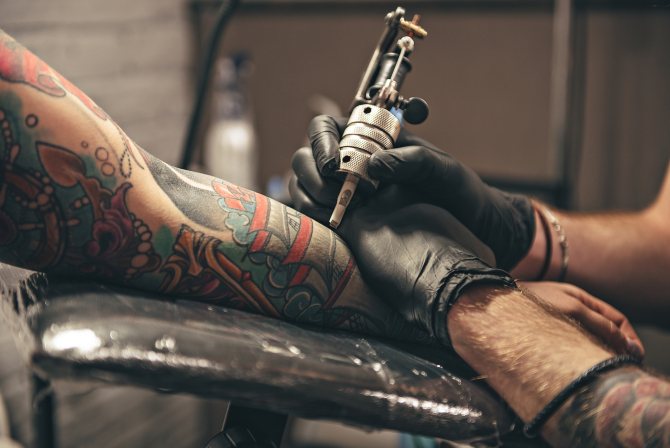

Source: pinterest.com
Celebrities continued to drive tattoo trends. Celebrity tattoos grew in popularity, thanks in large part to singer Rihanna.
2010s
The 2010s saw trends in both the design and placement of tattoos. Small tattoos in unusual places, such as fingers or behind the ears, are now very popular. Many people choose quirky and creative designs.
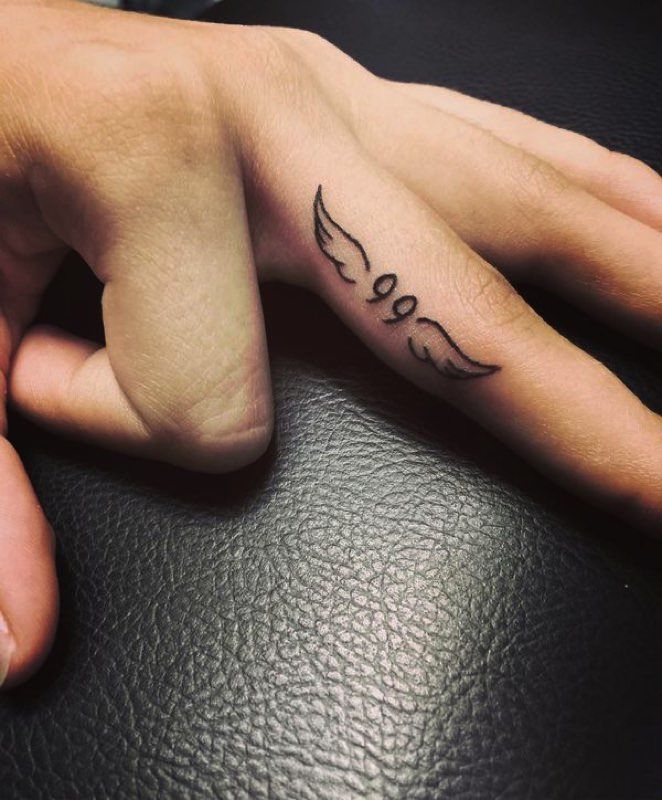

Source: pinterest.com
One of the most popular tattoo designs is the mustache tattoo on a small finger. Other popular trends include the infinity symbol, feathers and increasingly popular tribal tattoos.
Oceania is a special region of tattoo history
In the culture of Oceania, tattooing has occupied a central place comparable to what we have with religious painting. Tattoos were applied as a sign of initiation and to identify status. The first Europeans who visited Oceania wrote that the natives tattooed themselves as a costume. But this is a naïve view. In Europe, for example, they wear orders, which speak of badges of military glory, but the inhabitants of Oceania, and bounty hunters in particular, have such functions as a tattoo. If you are a warrior and have collected many heads of your enemies, you deserve a certain tattoo, large and in a meaningful place. And women, lest they be kidnapped and taken away to another tribe, also had to put a corresponding sign on their body.
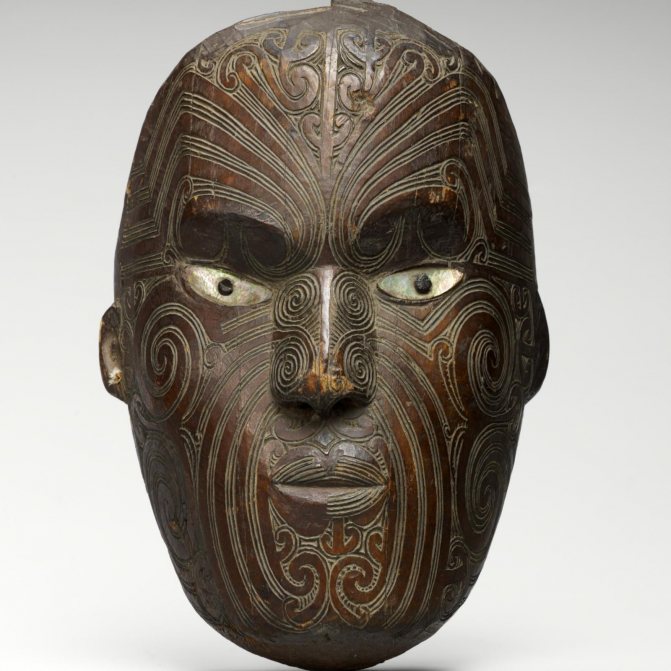

Koruru mask, or parata. 19th century. Source: Musée du Quai Branly Jacques Chirac, Paris
One cannot speak of Oceania as an undivided and monocultural region. Maori (New Zealand) tattoos are ta-moko tattoos that were applied to the face of both men and women. For men it was the whole tattoo, while for women it was concentrated around the lips and on the chin. The Maori tattoo was essentially a passport. They believed that if one entered the afterlife without a tattoo, one could not join the ancestors. You could spend eternity in purgatory because you would not be identified. It is a well-known fact that the British made sketches of Maori chiefs, but when they showed them to the person who was portrayed, he did not recognize himself because some nuances of the tattoo were not conveyed there. For them the tattoo is inseparable from their personality just as for Europeans facial features are.
The purpose of the tattoo then and now
In ancient times, when there was no written language, people transmitted knowledge and communicated with the help of signs. Preserved in a large number of rock writings. The drawings of the objects of the world around us could serve for expression of ideas. That is, the same writing, only instead of letters, birds, animals, flowers, twigs and so on.
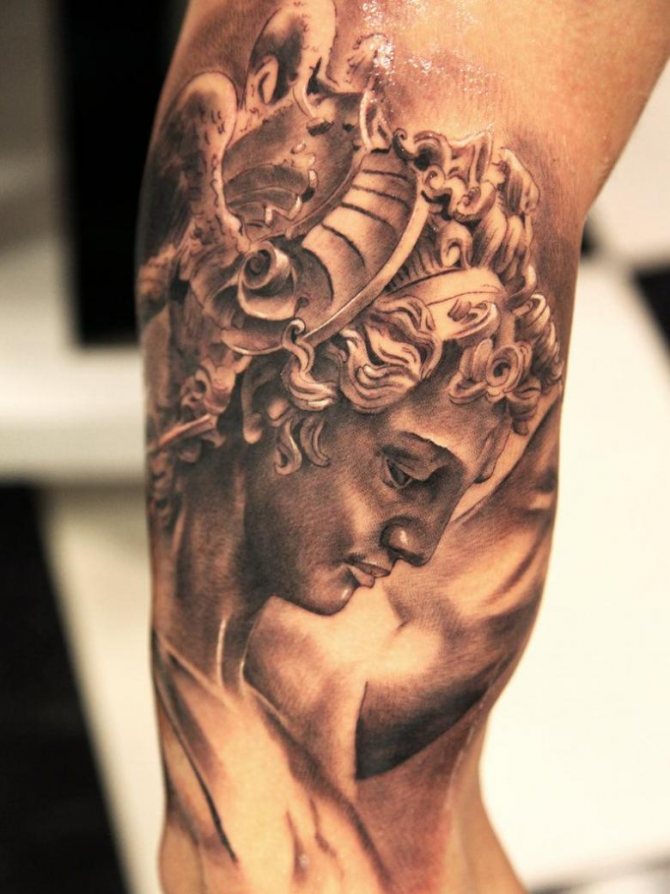

On the skin, too, the tattoo served as a sort of passport of the owner. Right down to the number and sex of the children.
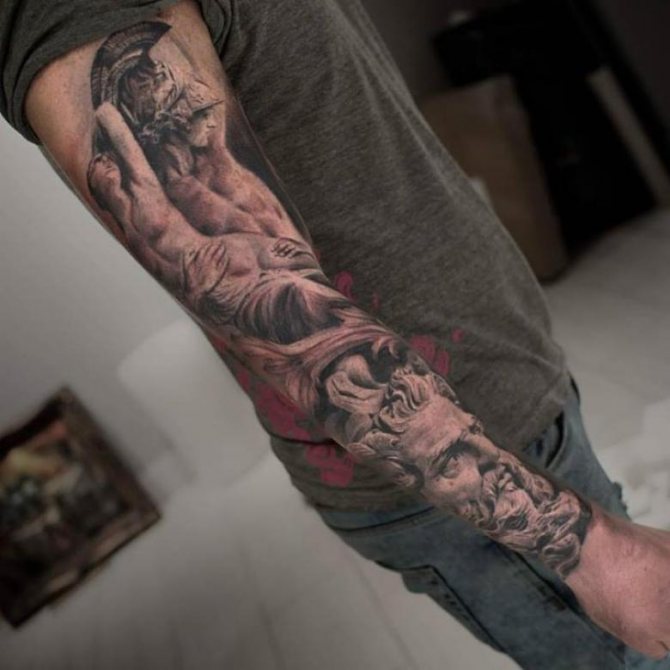

In modern times, tattoos are more for beauty. As for certain groups of people, subcultures, the choice of drawing is based on the sacred meaning of the symbol. For the average person, body painting also has meaning in this context, but rather superficially, without fanaticism.
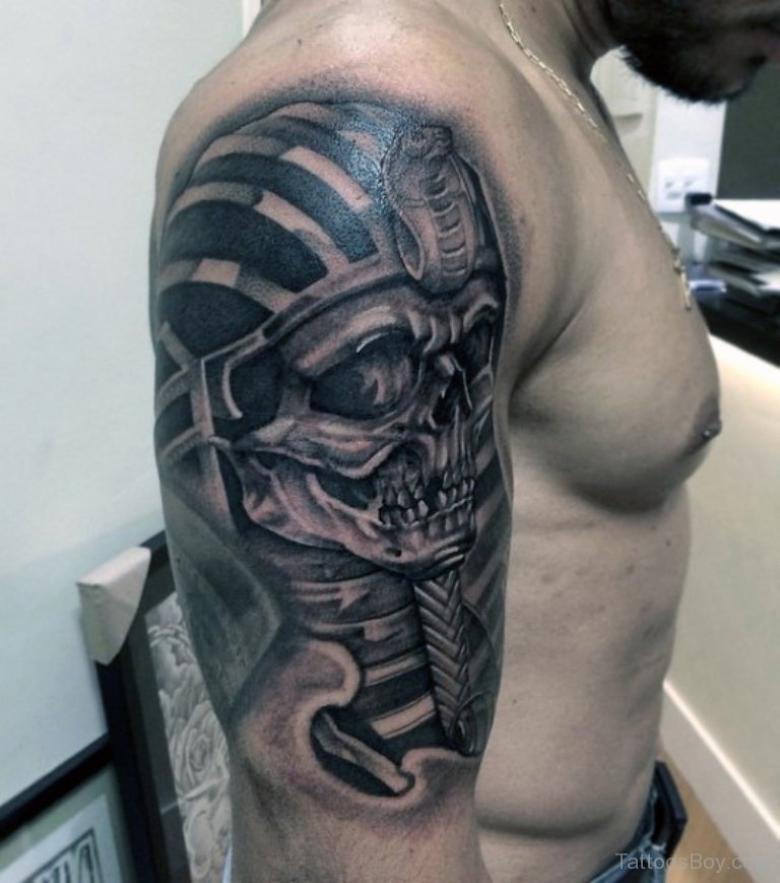

Still, it is necessary to remember that the image remains on the skin for a long time. Views on life, priorities may change. Perhaps the tattoo will already deliver mental discomfort. In order not to get into such a situation, it is advisable to choose neutral, positive pictures. For example, your zodiac sign, the image of a guardian angel.
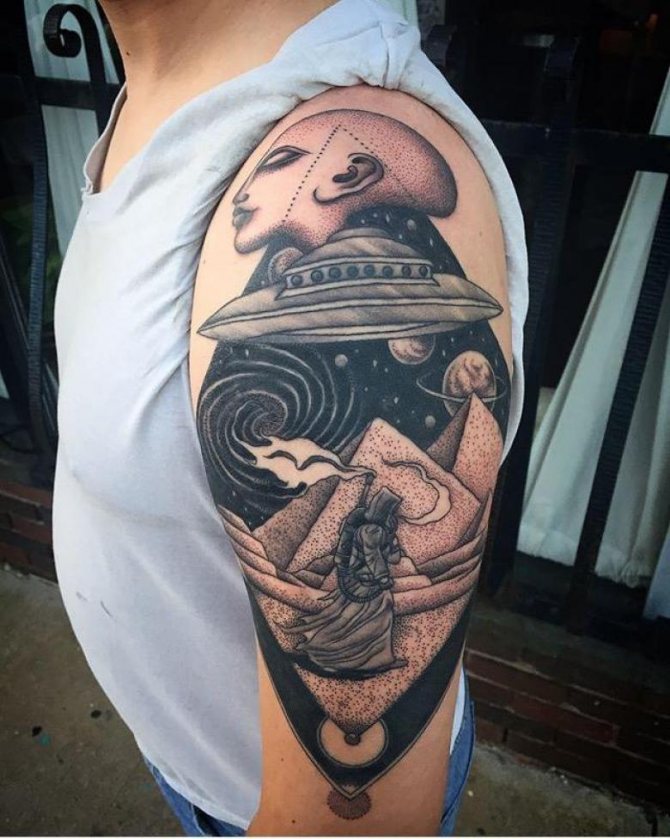

Dried heads
The Maori not only hunted for the heads of their enemies and then dried them, but they did the same with their relatives. In this peculiar way they kept the memory of their ancestors. For them the tattoo has such a serious meaning because it is preserved on their heads as well. These tattooed heads are for them an altar to their ancestors. This custom was not only among the Maori, but also in Jericho and in ancient Rome. In conflicts or military alliances, heads were taken from each other or exchanged. With the arrival of Europeans, dried heads (mokomokai) in one way or another ended up in many European museums. Now there is a strong wave of repatriation of tattooed heads in New Zealand.
The Branly Museum has returned all of the heads from its collection to New Zealand. This is an ethical point, because you can't compare human heads to ordinary exhibits. Although the Maori themselves traded heads with Europeans in the past, they traded them for muskets.
What did the ancient masters of tattooing use?
In ancient times, the tools used for tattooing were the simplest tools.
- The Indians used shark teeth and a mallet.
- In Thailand, crushed bamboo sticks were used.
- On the islands of the Pacific and Indian Oceans they practiced with stone fragments and fish bones.
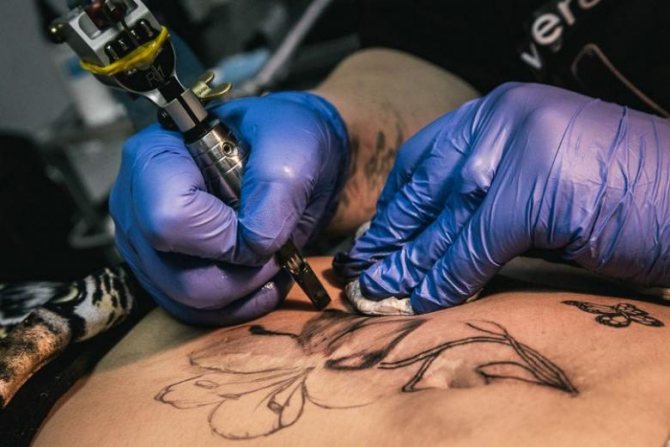

The Slavs used animal bones and wooden sharpened sticks. They applied wood ash to their skin or used clay seals with dyes. Oyster secretion, colored clay, and plant sap were in the use of the peoples of the southern hemisphere. In other parts of the earth charcoal and sap, soot, ochre, henna, cinnabar were used.
Incredible traditions of the Marquesas Islands
In men the tattoo was applied practically on the whole body, on all accessible places, and in women it has a more local character - the face, hands, legs. And male warriors were densely covered with a tattoo.
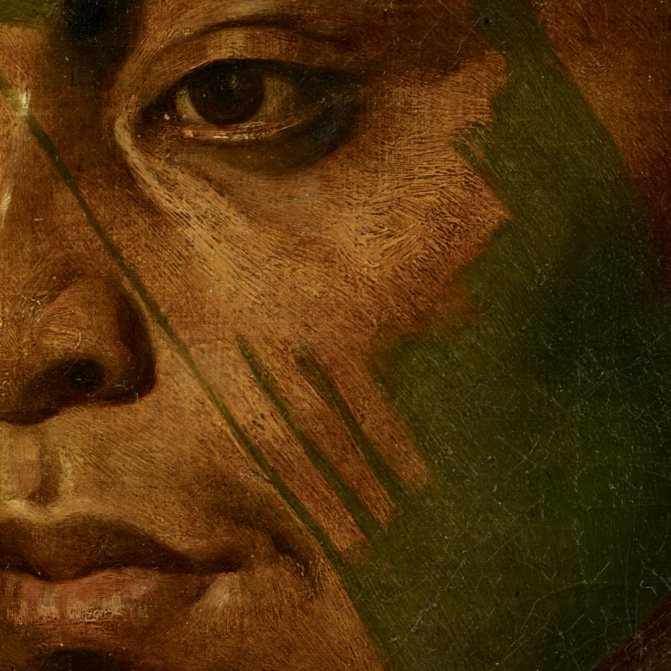

A tattooed inhabitant of the Marquesas Islands. Source: Jacques Chirac Quai Branly Museum, Paris.
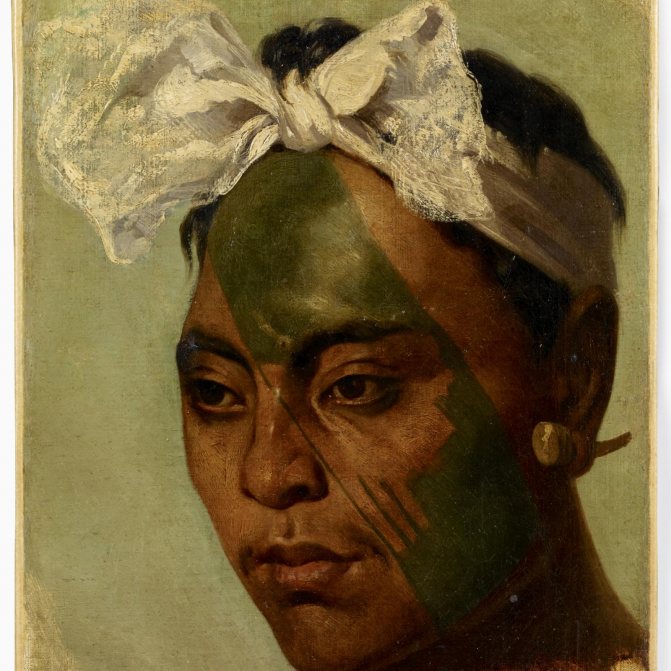

A tattooed resident of the Marquesas Islands. Source: Jacques Chirac Quai Branly Museum, Paris
The Europeans, seeing for the first time swarthy people covered with tattoos, did not immediately realize that this is a completely tattooed person in front of them, and then were amazed by this subtle skill of tattooing. The Pushkin State Museum of Fine Arts has a collection of engravings made from drawings of the Krusenstern expedition, which depict incredible Marquis warriors, entirely decorated with tattoos.
Now Dmitry Babakhin is studying the tattoos he sees on the engravings and sketches that the first travelers brought back with them and is trying to revive it. He does tattoos on the bodies of modern people. Dmitry says he is even allowed to have it applied to the indigenous people of the Marquesas Islands, which means honor, respect and recognition on their part.
How tattoos began
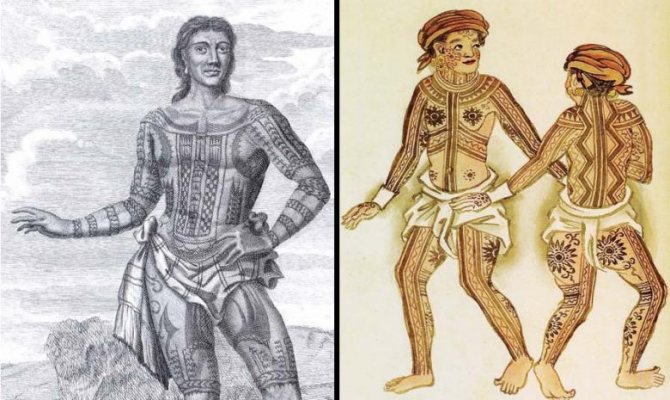

The word "tatoo" comes from the fusion of two words belonging to two different peoples. From the Marquesan language "ta" means "sign" and from the Tahitian word "too" means wound.
Ancient tattoos appeared during the primitive communal system. It was possible to find out everything about a person. What tribe, what status, what magical power calls for.
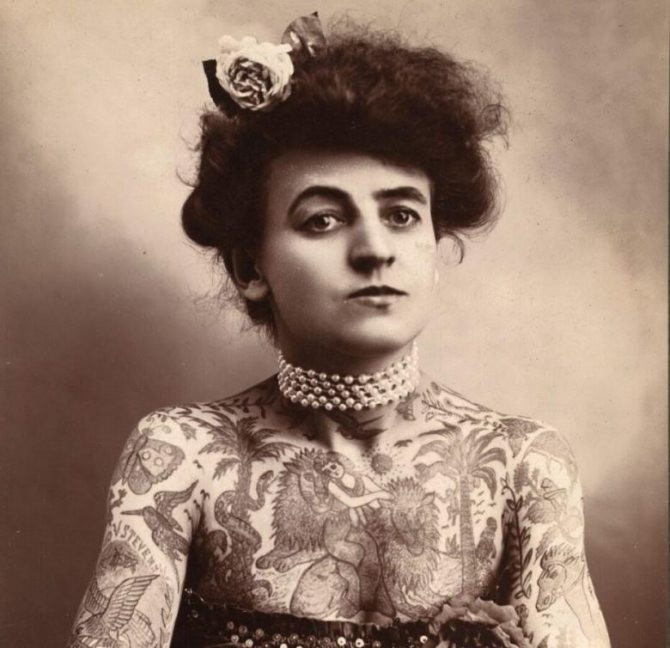

The possibility of long-term pigmentation began by chance. It turned out that soot which has got on a fresh wound remains as a black stain on the skin for a long time. They began to use this quality of soot for artificial application of wounds. They began to cut on the skin the desired signs and to rub soot into the wounds. Sketches of ancient tattoos were performed directly on the living skin.
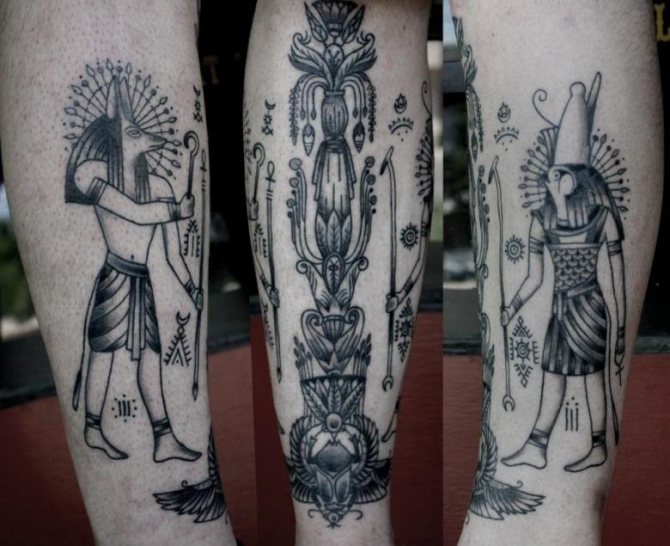

Thai Sak Yan Tattoo
In Thailand, tattooing is a whole ritual with the recitation of mantras. The ritual is performed by a Buddhist monk. In the composition of the ink, which is applied to the tattoo sometimes even adds ashes of the burnt especially devout people. The world of Thai tattooing is very complex, with elements of Buddhism, Brahmanism and animism. It is a subject of serious study and has now become very popular around the world, in particular thanks to Angelina Jolie.
The Thai tattoo is not applied randomly. First the master guesses, talks to the person he is going to make a tattoo, and only then chooses a magic sign that can help him in this or that situation, it can bring success in life or give courage in the fight. Muay Thai fighters need tattoos for protection, strength and courage.
The tools that were used to create tattoos
Not only have social perceptions and popular designs changed over time, but so have the tools and ink used to apply tattoos. For today's machines, tools are made from a variety of materials.
The tattooing tools used in Polynesia require two people to tattoo. These tools consist of a simple needle and a hammer. The tattoo artists make several small incisions in the skin. The ink is then directly hammered into the skin where the incisions were made.
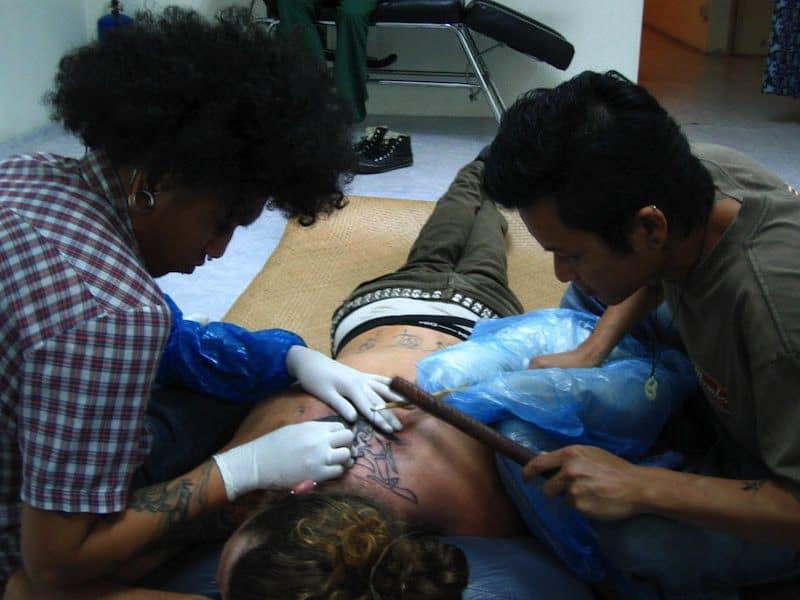

Source: pinterest.com
Similar methods are seen in tribal communities, where tattoo culture reflects the right to withdraw. Ancient Egyptian tattoo needles were made of bronze. Needles came in a variety of sizes to create both elaborate and basic designs.
The first tattoos used homemade ink. They were probably made from ash, soot, and mixed with oil or breast milk. Samoan tattoo ink is traditionally made from a candelabra which is smoldered over a hot fire. The soot is then collected from the burning nut and mixed with sugar and water.
Latin American Tattoos
In Latin America there were modifications of every kind of tattoo imaginable. Each region had its own tools, including tattooing with cactus needles.
A curious type of tattoo can be seen in members of local organized crime groups in El Salvador, Mexico and Colombia. The style of the tattoo is chicano, which also goes back to the tattoos of American Indians, Spanish sailors, and criminal bosses. The tattoo is often applied to the entire body and extends to the face. It becomes a sign of asociality. A modern tattoo on their body can be a whole story about that person's life story.
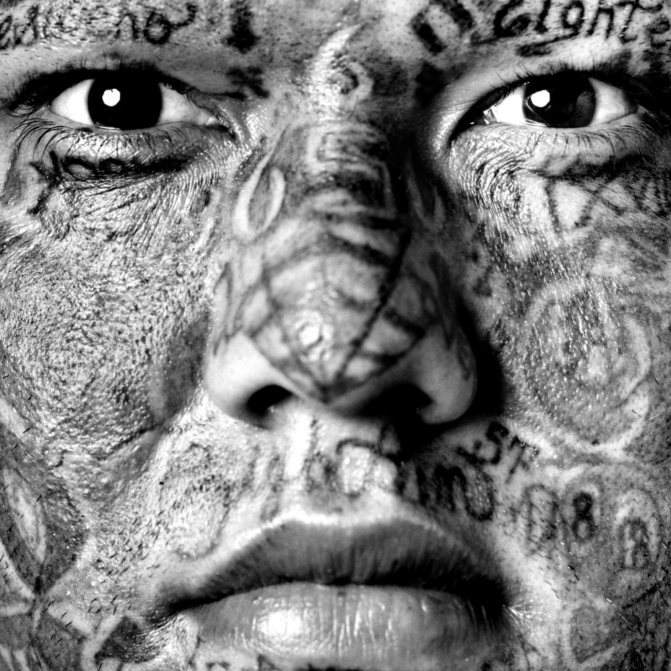

Isabel Muñoz. Portrait of a Mara gang member. Source: Collection of the author, Madrid © Isabel Muñoz, 2020
Renowned Spanish photographer Isabel Muñoz took a whole series of photographs of members of the Maras gang (full name Mara Salvatrucha) in prisons. Several images from this series can be seen at the exhibition in the Pushkin State Museum of Fine Arts. In the twentieth century, the tattoo becomes an attribute of criminal subcultures
Researchers of contemporary Russian tattoo and the one applied by "Maras" noticed that they have the same functionality. It is both a kind of passport, a "who you are" and an autobiography of "what you were in for". But the Russian criminal tattoo has a more sophisticated nature, with more complex iconography. It is difficult for an uninitiated person to understand what what what he sees means. For example, even from where the picture is located, its meaning can change. Ring tattoos can be classified as a kind of heraldry: depending on which fragment is painted in black and which in white, and whether there is a crown over it or not, its meanings change as well. This is a very complex developed iconographic system. Unfortunately or fortunately, it is gradually disappearing. Specialists working in Butyr prison say that this is a weakening and possibly even dying tradition. Thieves' traditional tattoos are now practiced less.
Criminal tattooing, globalization and social media
A Yakuza mobster who ran from Japanese justice for twenty years was found in Thailand by a tattoo he had been tattooed in prison. One day he was playing chess in the street and you could see his tattoo on his back. He was photographed by some tourist and posted on his account. The photo received a huge number of likes and began to walk around the network. The photo was seen in Japan and identified. Apparently, not in vain the philosophy of Japanese tattooing suggests that the tattoo is not worth to flaunt, that it is a hidden beauty and that is why it is good.
Electrosila: the first tattoo machine
Over time, the need for circus legends completely disappeared. A tattoo-sensation of the end of XIX century became a married couple Frank and Emma De Burgh, who became famous on the whole world as one of the first people, whose drawings were applied by an electric tattoo-machine.
In 1891, the American Samuel O'Reilly invented the world's first tattoo machine, based on Thomas Edison's electric pen used for copying documents. O'Reilly improved on Edison's invention by equipping the machine with an ink reservoir and starting to use a bunch of interchangeable needles instead of one. The new device worked at a high speed, making several punctures per second.
The couple Frank and Emma De Bourgh were the first to try it out: an image of the Last Supper appeared on Emma's back, and on Frank's body - a huge crucifix with the inscription "Golgotha Mountain".
The history of tattooing in Europe
In ancient Greece and Rome, tattooing was traditionally used to designate slaves and criminals. The ancient Greeks borrowed this practice from the Persians. In ancient Greece, tattoos were not done for decoration, there was a cult of the human body and it was believed that it did not need it, it was perfect as it was. But the Greeks and Romans were not the only inhabitants of Europe. Their neighbors on the continent were barbarian tribes who had their own tattoos. Mention of this is in ancient sources, although it is difficult to imagine how these tattoos looked like, how they were applied, to whom and why.
The Europeans recalled the ancient roots of the tattoo in the early modern period when they saw the tattoo of the inhabitants of North America, having begun its colonization. The discovery of the American tattoo was a culture shock for them. They began to look for some parallels with their own history and remembered that in Europe there were also people who walked around naked and were tattooed. Images of perhaps the most mysterious European people, the Picts and the Bretons, began to appear. But it was only a figment of the imagination of the explorers of those times.
The first available images of North American Indians first appeared in a multi-volume history of America published by Flemish publisher and engraver Theodore de Brees. He made for it engravings from drawings that had been made by members of French and English colonizing expeditions. The French artist Le Moyne de Morgue, who was in Florida, and the English artist John White, who was in North America on behalf of Francis Drake. The encyclopedia sold out in huge numbers for its time. Along with images of tattooed Indians, Theodore de Brie included images of the Breton and Picts, the population of ancient Europe, to make the tattoo phenomenon more understandable to people. The tattoo in early modern times was associated in Europe as a sign of the barbarian, and in the eighteenth century, as for example by Rousseau, the noble savage, a popular character in Enlightenment literature. But certainly the boundary between the civilized world and the world where the tattoo was applied was drawn.
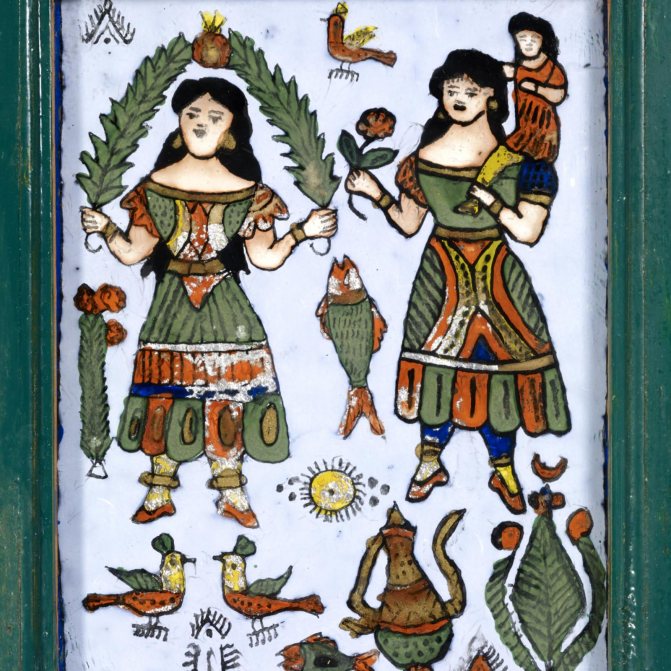

The screen. North Africa and the Middle East. XIX century. Source: Jacques Chirac Museum on the Quai Branly, Paris
At fairs, people who entertain gawkers with invented stories about being kidnapped by savages under mysterious and fatal circumstances and getting tattoos are a big hit. On this wave, professional tattoo artists are also beginning to appear, traveling from city to city with screens and suitcases of tattooing equipment.
By the XIX century, tattooing becomes an indispensable part of a number of subcultures. It begins to spread in the army and among sailors.
Maximalists
In 2006, the Guinness Book of World Records listed Lucky Diamond Rich as the world's most tattooed man. His body is almost 100% covered in tattoos, including his genitals, ears and mouth.
The idea of covering his entire body with tattoos came to him as a child, but he put it off for a long time until he got his first one: a picture of a small juggling mace on his thigh. From then on, he gradually got more and more tattoos until they covered his entire body, including his eyelids. After that, he began covering his skin with light tattoos on top of the dark ones, as well as adding color.


Lucky Diamond Rich.
© en. wikipedia.org/wiki/History_of_tattooing
In second place among men is Tom the Leopard. He earned this nickname because of his rainbow-colored skin to match the skin of a leopard. Many people thought he was nuts, but he didn't care.
Twenty-eight years of his life were spent serving in the Special Forces. Then he realized that "all is dust" and left the civilized world for the Isle of Skye, to live solitary in a cabin, reading books, walking through the woods on all fours and covering his shits with only a loincloth. His body was 99.9 percent covered with a spotted tattoo and fangs were inserted, which didn't stop him from traveling by boat once a month for his pension and groceries for the rest of his life.
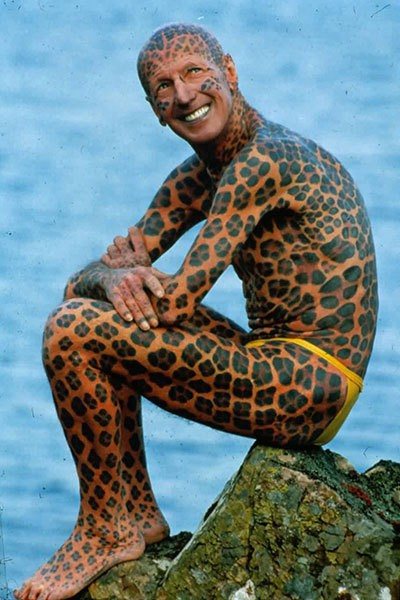

Tom Leopard
© en. wikipedia.org/wiki/History_of_tattooing
The world's most tattooed woman is believed to be 59-year-old Julia Gnuse. Her story is different from Lucky's. A rare genetic disease, porphyria, has set the vector for Julia's life. It consists of her skin breaking down when exposed to the sun. To hide the multiple scars, the thirty-year-old began covering her body with images of characters from American TV shows, movies and animations. More than four hundred tattoos saved Julia from complexes and ugly scars.
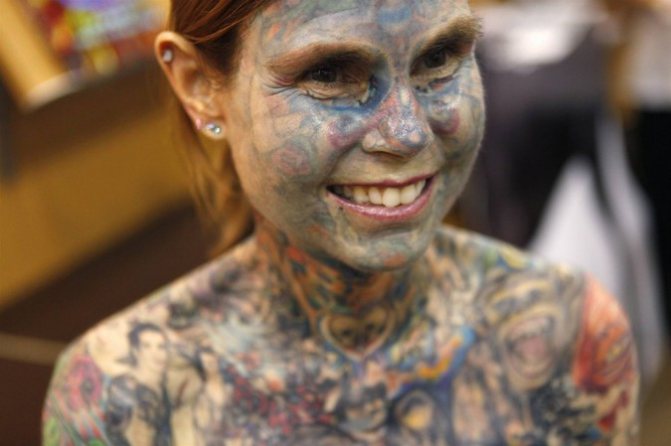

Julia Gnuse
© en. wikipedia.org/wiki/History_of_tattooing
Everyone knows Rick Genest, aka Zombie Boy, fell ill with the idea of death at the age of 15, after surgery to remove a tumor from his brain. At 21 he met Frank Lewis, who came up with a concept for him and for himself a stable income for the next 5-7 years.
The realization of Mr. Lewis' creative ambitions brought Rick worldwide fame, social adaptability in the fashion world, and handsome royalties.
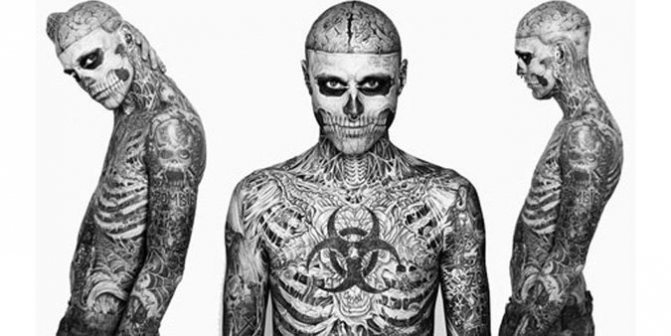

Rick Genest
© en. wikipedia.org/wiki/History_of_tattooing
The first person in Russia to get a tattoo on the eyeball was Muscovite Ilya Bomber. When applying such a tattoo, a needle is inserted into the eyeball and the dye is injected, which subsequently spreads out on its own. This method is not safe, and there is always the risk of losing your vision.
However, it will come as a surprise to many people that this procedure is over two thousand years old. It has been used to improve vision. Roman physicians used it to treat white spots on the iris. The physician Galen performed eye surgery as early as 150 B.C.
Before the 19th century, physicians began to use needles with ink to tattoo the cornea to repair deformities and opacities. Various designs of needles for the procedure were made - fluted needles, cluster needles, the first eye tattoo machines and so on. In the twentieth century, advertisements were replete with the possibility of changing the color of the eyes by a similar method.
The injection method of eye tattooing was invented by Shannon Laratt and Dr. Howie. The exertion was performed for the first time on July 1, 2007.
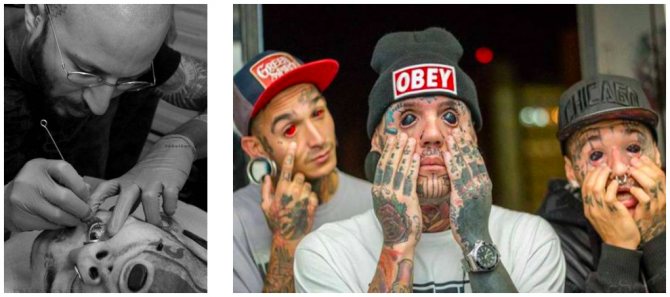

© en. wikipedia.org/wiki/History_of_tattooing
Tattooing in Russia
In written sources there are mentions of tattooing among the ancient Slavs. But to speculate about the ancient period of tattooing in Russia is difficult. Reliably known only that under Peter I the branding of convicts and thieves on visible parts of the body was introduced, but exactly tattooing as such, that is, the introduction of dye under the skin, was not widespread. On a mass and voluntary basis tattooing as in the rest of Europe began in the late XVIII century, when Europeans began to travel to remote corners of the Pacific, first Cook, and then the Russian expeditions. Many sailors, members of these expeditions tattooed themselves to commemorate the places they visited.
The most interesting story is that of Tolstoy the American, who was a member of the Krusenstern expedition. He was a member of the highest ranks of the officers, but he was an extremely eccentric person. All the members of the expedition left a recollection in their diaries that he locked himself in his cabin with a tattooist for several days and came out of there completely tattooed, and then shocked everyone with his tattoos.
As a result of these voyages, two interesting phenomena emerge. Natives were brought back from expeditions and shown as curiosities, because European businessmen quickly figured out that there was good money to be made on this. The tattooed "savages" of local manufacture also quickly began to appear, and the story was invented that they had been abducted by the natives and forcibly tattooed.
A separate, particularly interesting page in this story is that of Westerners who, for one reason or another, ended up on remote islands. They were either shipwreck victims or deserters disembarked there. They assimilated willy-nilly with the natives and were forced to live with them for many years. The story of the Frenchman Joseph Cabri, or Jean-Baptiste Cabri, there are two versions of the name of this character who ended up in the Marquesas Islands, is remarkable. Most likely he was landed there for bad behavior. He completely assimilated with the local population, married the chief's daughter, learned the language, learned to swim as Marquis and was entirely covered with tattoos. Krusenstern's expedition spent 12 days off the Marquesas Islands met this Frenchman there and took him with them. He did not want to leave the islands, because his life there was beautiful and carefree. It happened by chance.
According to the recollections of Kruzenshtern and the expedition participants, at some point Cabri fell asleep on the ship, suddenly a storm broke out and the ship was carried away into the open sea. He was offered the chance to jump out so that he could return, but Cabri refused. As a result, he ended up in St. Petersburg and became a teacher of navigation at the Kronshtadt School. After a while he returned to his native France and was at first a star there. But gradually interest in him disappeared. He began to perform at fairs, for which he made himself several more tattoos and a costume of feathers and palm leaves, which had nothing to do with what the Marquesas Islanders wore. He acquired these extra props for greater effect.
Reasons for the origin of the tattoo
It is believed that with the emergence of mankind, tattoos decorated the body in places of scars from the fight with neighboring tribes and with wild animals. Also invented insignia in the form of tattoos in order to highlight the important man.
Later, other reasons for tattoos appeared on the globe:
- The transition from childhood to adolescence. Boys who reached adolescence were initiated into men by making a mark in the form of a tattoo. Girls were given this tattoo after their first period.
- Treatment. Tattoos were applied to the skin to prevent and cure diseases.
- Cosmetics. In the Majori tribe, women were tattooed along the outlines of their lips. It was something akin to cosmetics.
- Protection. The Eskimos, Yakuts, Chukchi had a tattoo that protected the wearer from natural phenomena.
- Talisman. Tattoo was considered a talisman against various evil spirits, a talisman for good luck.
- Patronage. In certain tribes it was believed that people have protectors among animals. For example, a tattoo in the form of a bear or eagle protected from disasters and contributed to the work.
- Seduction. In Sumer and Babylon, women painted their bodies with signs of the celestial luminaries to attract the attention of men.
- Branding. Slaves were marked with a tattooed identification mark, and the mark singled out the offender.
- Intimidation. To create a militant and intimidating appearance in Polynesia, men were tattooed on their bodies in the form of shark teeth or spearheads.
- Identification mark. Women of some nations had special tattoos to signify their marital status.
- Religion. Pilgrims had religious tattoos. Believers tattooed a cross or the initials of Jesus Christ.
- A license plate. In Russia during the reign of Peter the Great soldiers had a cross and a number drawn on their wrists with dry powder. It was necessary in order to know which army unit the wounded or killed soldier belonged to.
Tattoo exhibition in Moscow
At the exhibition, which takes place in the Gallery of European and American Art XIX-XX centuries (Volkhonka, 14) from March 3 to May 31 you can learn about the stages of tattooing in different regions of the world using different materials: from traditional art objects to the works of contemporary artists. The works of today's active tattoo artists will be shown on the silicone models created specially for the exhibition - impressions of body parts of real people. Among the artists who have performed tattoo designs are leading contemporary masters from around the world: Philip Liu, Henk Schiffmacher, Jack Rudy, Guy Atchison, Alex Binney, Dr. Lacra, Tin-Tin, Paul Booth, Horiyoshi III, Leo Sulueta and others.
Natalya Morozova was interviewed by Varvara Shkermeneva, Deputy Head of the Department of Exhibition Organization and Aleksandra Savenkova, Leading Specialist for Exhibition and Exhibition Activities at the Pushkin State Museum of Fine Arts.
Summary
Tattoos are an integral part of some cultures. In the Western world, it has taken time for decorative ink to become socially acceptable. Only in the last fifty years have tattoos become popular.
The evidence for tattooing in ancient civilizations is amazing. Tattoos of ancient eras tended to be associated with medical treatment, unlike the cosmetic value they have today. There are still many changes to come in the development of trends and trends in the tattoo world, who knows where it may lead humanity
